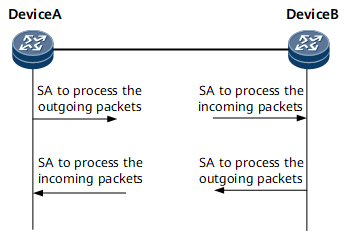IPsec SA
IPsec provides secure communication between IPsec peers (two communication ends).
An SA functions as a convention for some elements of IPsec peers, and is used to protect protocol packets, providing IPsec with essential functions. It defines the security protocol to be applied, encapsulation mode, authentication algorithm, and shared key for protocol packets protection. The security protocol can be configured as either Authentication Header (AH) or Encapsulating Security Payload (ESP).
SAs are protocol-specific. If Device A and Device B use both AH and ESP for secure communication, four SAs are required on Device A. Two SAs (one for incoming protocol packets and one for outgoing protocol packets) are configured for AH and the other two SAs (one for incoming protocol packets and one for outgoing protocol packets) are configured for ESP. Similarly, four SAs with equivalent relationships are required on Device B.
An SA is uniquely identified by a 3-tuple, which comprises the Security Parameter Index (SPI), destination IP address, and security protocol (AH or ESP). The SPI is a 32-bit number generated to identify an SA and is carried in the AH or ESP header during transmission.
SA Establishment Modes
In manual configuration mode, you can set some parameters on both ends. After parameters on both ends match and the negotiation is successful, an IPsec SA is established. The manual configuration mode is complex, because all information required for establishing an IPsec SA needs to be manually configured. Specific advanced features (such as periodic key update) of IPsec are not supported. However, the advantage of the manual configuration mode is that IPsec functions can be implemented without relying on IKE. Currently, the manual configuration mode is mainly applicable to protocol packet authentication, for example, RIPng, OSPFv3, IGMP, MLD, PIM, and DHCPv6 Relay.
The automatic negotiation mode is initiated and maintained by IKE. Both parties establish an SA after matching and negotiation based on respective security policy library, without user intervention.
IKE is a hybrid protocol. It is based on a framework defined by the Internet Security Association and Key Management Protocol (ISAKMP). IKE provides services for IPsec such as key exchange for automatic negotiation and SA establishment, simplifying IPsec use and management.
IKE Security Mechanism
Perfect Forward Secrecy (PFS): If a key is cracked, security of other keys is not affected because these keys do not have a legacy relationship. PFS is ensured by the DH algorithm. This feature is implemented by adding the key exchange mechanism to IKE phase-2 negotiation.
Authentication: Authentication is used to verify identities of both communication parties. In the pre-shared key (PSK) method, an authenticator is used to generate a key for a party. If authenticators are different, the generated keys are different. The authenticator is a key factor used to verify identifies of both parties.
Identity protection: Identity data is encrypted for transmission after a key is generated, thereby protecting the identity data.
